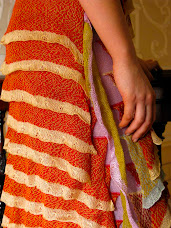
For those who noted there is practically a year missing on this blog, a year of familial illness and death was the primary contributing factor.
ecomodista will be on location during april, may, and june in the EU working on a new project that will be published by Stewart Tabori Chang: hand knitting. Numerous devotees of ecomodista will find this unbelievable, however, the construction of clothing is simply architecture on a smaller scale. In fact, one of ecomodista’s projects is to produce hand knit wool yurts for the homeless. Hand knitting also produces extremely warm garments, encouraging less dependency on heating in the winter and cooling in the summer. Yes, you may have heard me scoff about the use of summer cashmeres, but the insulating quality of wool or cashmere works for warm and cold seasons.
Wondering whether analog images create a greater carbon footprint than digital, ecomodista will keep a log of energy consumption comparisons. To decrease the carbon footprint of travel, eomodista will fly from NYC to Dublin and thereafter travel only by train through out the EU.
Sustainable fashion responds to the insanity of “throw away” garments, and is fair trade, organic and less water intensive, recycled, and aware of how to reduce environmental side effects of manufacturing fibers, textiles, and clothing. ecomodista will interview knitters, hand knit designers, and groups that are creating new industries in their own countries as a result of fair trade ethics. As President Obama has stated, we must again produce; ecomodista assumes he is referring to objects, not services--how many more day spas and nail bars does a country need?
The UK’s Department for Environment, Food and Rural Affairs (Defra) estimates that, annually, the clothing and textiles sector in the UK alone produces around:
3.1 million tons of CO2
Two million tons of waste
70 million tons of wastewater
1.5 million tons of unwanted clothing being landfilled
see http://earth911.com/blog/2009/02/24/sustainable-clothing-initiatives-launch-at-london-fashion-week/
Imagine what the statistics must be in India, Asia, and the Americas. Hand knitting has often provided the only affordable means of producing stylish clothing, to such an extent that during the 1930’s & 1940’s knitters would unravel a previous season’ sweater to re-knit in a current style.
Influenced by her editor at STC, Melanie Falick, a well known knitter and editor, ecomodista will explore knitting traditions, old and new, in the UK, EU,Scandanavia, the Baltic, and the Eastern EU. Out takes, and other documents tracing the creation of this work will be posted on ecomodista’s blog whenever possible. see http://www.hnabooks.com/category/show/94
Wondering whether analog images create a greater carbon footprint than digital, ecomodista will keep a log of energy consumption comparisons. To decrease the carbon footprint of travel, eomodista will fly from NYC to Dublin and thereafter travel only by train through out the EU.
Sustainable fashion responds to the insanity of “throw away” garments, and is fair trade, organic and less water intensive, recycled, and aware of how to reduce environmental side effects of manufacturing fibers, textiles, and clothing. ecomodista will interview knitters, hand knit designers, and groups that are creating new industries in their own countries as a result of fair trade ethics. As President Obama has stated, we must again produce; ecomodista assumes he is referring to objects, not services--how many more day spas and nail bars does a country need?
The UK’s Department for Environment, Food and Rural Affairs (Defra) estimates that, annually, the clothing and textiles sector in the UK alone produces around:
3.1 million tons of CO2
Two million tons of waste
70 million tons of wastewater
1.5 million tons of unwanted clothing being landfilled
see http://earth911.com/blog/2009/02/24/sustainable-clothing-initiatives-launch-at-london-fashion-week/
Imagine what the statistics must be in India, Asia, and the Americas. Hand knitting has often provided the only affordable means of producing stylish clothing, to such an extent that during the 1930’s & 1940’s knitters would unravel a previous season’ sweater to re-knit in a current style.
Influenced by her editor at STC, Melanie Falick, a well known knitter and editor, ecomodista will explore knitting traditions, old and new, in the UK, EU,Scandanavia, the Baltic, and the Eastern EU. Out takes, and other documents tracing the creation of this work will be posted on ecomodista’s blog whenever possible. see http://www.hnabooks.com/category/show/94







